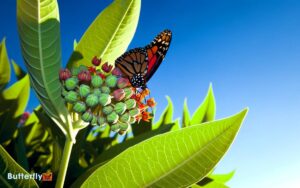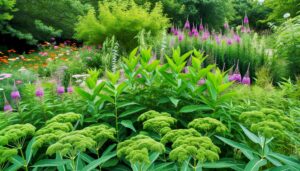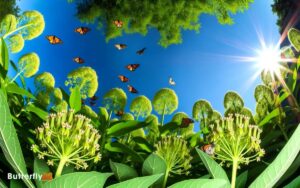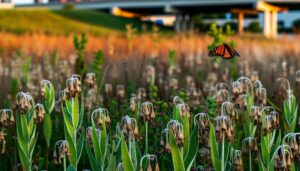Essential Plants for Monarch Butterflies in Texas
The Piedra Herrada Sanctuary in Temascaltepec serves as a pivotal overwintering habitat for millions of monarch butterflies, who migrate up to 3,000 miles guided by environmental cues and Earth's magnetic field. This sanctuary is best visited between late November and early March to experience peak butterfly activity.
Conservation efforts like habitat preservation and creation of butterfly-friendly corridors are continually emphasized. The sanctuary can be accessed via the Toluca-Valle de Bravo highway, with guided tours offering scientific insights into the monarchs' lifecycle and ecological significance.
Visitors learn about conservation and enjoy the natural beauty of the oyamel fir forests. Explore further for a deeper connection with this natural wonder.
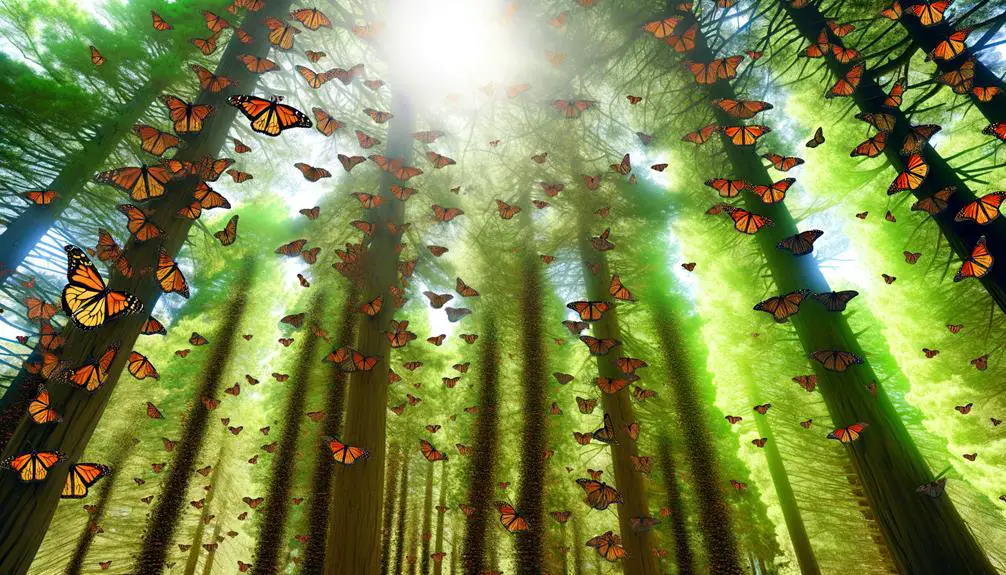
Key Takeaways
- The best time to visit Piedra Herrada for monarch butterflies is from late November to early March.
- Guided tours offer educational insights into monarch migration and conservation efforts.
- The sanctuary is accessible via the Toluca-Valle de Bravo highway, approximately 100 kilometers from Mexico City.
- Scenic walking trails through oyamel fir forests provide optimal wildlife observation opportunities.
The Monarch Migration
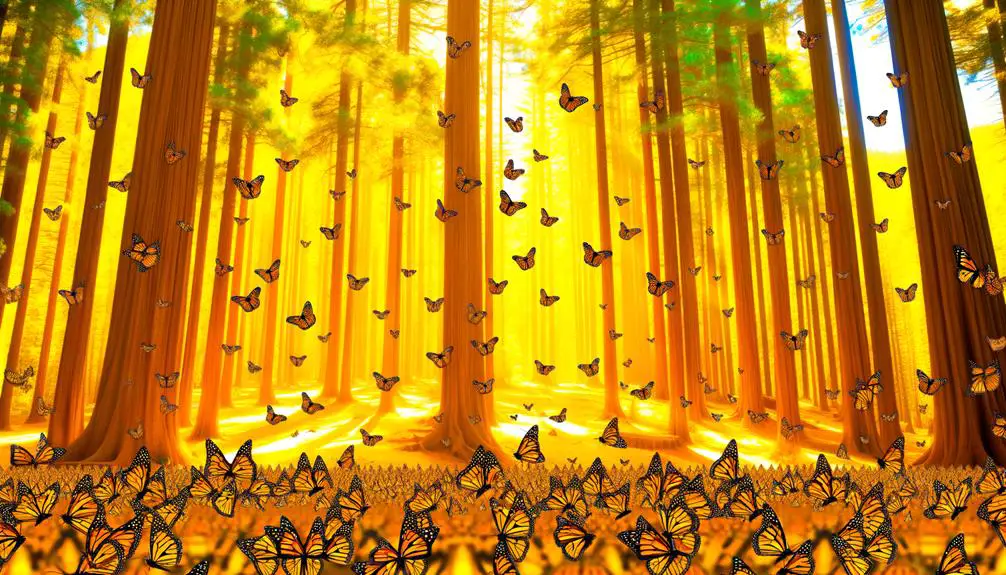
Each year, millions of monarch butterflies begin a remarkable migratory journey spanning up to 3,000 miles, traveling from North America to their winter sanctuaries in central Mexico.
This extraordinary phenomenon is driven by instinctual navigation mechanisms and environmental cues such as temperature and daylight. Scientific studies reveal that monarchs utilize a combination of the Earth's magnetic field and the position of the sun to traverse vast distances.
The journey is fraught with perils, including habitat loss and climate change, which threaten their survival. Conservationists advocate for preserving critical habitats and creating butterfly-friendly corridors to guarantee these magnificent creatures continue their iconic migration.
The monarchs' resilience and determination symbolize freedom and the intricate balance of our natural world.
Best Time to Visit
Understanding the best time to visit monarch butterfly sanctuaries requires considering both their migratory patterns and the environmental conditions that support their survival.
The ideal period to experience the breathtaking sight of millions of monarchs at Santuario Piedra Herrada is from late November to early March. During this period, the butterflies cluster in the oyamel fir forests to escape the harsh winter in North America.
- Late November to early March: Peak butterfly presence.
- Morning visits: Witness butterflies warming up and becoming active.
- Weekdays: Fewer tourists, more serene environment.
This timing guarantees visitors not only witness the monarchs at their most populous but also support conservation efforts by adhering to sustainable tourism practices.
Getting to Piedra Herrada

Reaching Santuario Piedra Herrada involves a journey through the scenic landscapes of central Mexico, with the sanctuary located approximately 100 kilometers west of Mexico City.
The most common route is via the Toluca-Valle de Bravo highway, which offers a mesmerizing drive past verdant hills and picturesque villages.
For those seeking public transportation, buses from Mexico City's Terminal Poniente provide frequent services to Valle de Bravo, followed by local taxis or buses to Piedra Herrada.
Personal vehicles allow for flexible travel times and the opportunity to explore surrounding areas.
It is advisable to check road conditions and weather forecasts, as the region can experience sudden climatic changes.
This journey not only promises natural beauty but also supports conservation efforts for the majestic Monarch butterflies.
Guided Tours
Guided tours at the Monarch Butterflies Sanctuary are led by knowledgeable local guides who provide invaluable insights into the biology and migration patterns of these remarkable insects.
These tours follow scenic walking trails, allowing visitors to immerse themselves in the natural beauty of the sanctuary while learning about its ecological significance.
Additionally, the tours offer unparalleled opportunities for wildlife observation, enhancing the educational and experiential value for all participants.
Knowledgeable Local Guides
Expert local guides play an essential role in enhancing the educational experience of visitors to the Monarch Butterflies Sanctuary, providing in-depth knowledge about the monarchs' lifecycle, migration patterns, and the ecological importance of their habitat. Their expertise offers invaluable insights, ensuring that tourists not only enjoy the breathtaking spectacle but also understand the critical conservation efforts required to protect these magnificent creatures.
Lifecycle Education: Detailed explanations of the monarchs' complex life stages, from egg to adult.
Migration Insights: Information on the 3,000-mile journey that monarchs undertake annually.
Ecological Importance: Understanding the role of monarchs within the ecosystem and their impact on biodiversity.
Conservation Efforts: Knowledge about ongoing initiatives to safeguard the sanctuary and promote sustainable tourism.
These guides empower visitors with the freedom to appreciate and advocate for conservation.
Scenic Walking Trails
Exploring the scenic walking trails with a guided tour offers visitors an immersive experience, allowing them to witness the natural beauty and intricate ecosystem of the Monarch Butterflies Sanctuary.
The trails, meticulously maintained to minimize ecological disruption, traverse through dense forests of oyamel fir trees, essential to the Monarchs' overwintering habitat.
Guides, often local experts, provide invaluable insights into the sanctuary's flora and fauna, explaining the symbiotic relationships that sustain this delicate environment.
The trails are designed to guarantee minimal human impact while maximizing observational opportunities, fostering a deeper appreciation for conservation efforts.
This structured approach not only protects the sanctuary but also enriches visitors' understanding, empowering them to advocate for the preservation of such significant natural habitats.
Wildlife Observation Opportunities
Visitors to the Monarch Butterflies Sanctuary are presented with unparalleled opportunities for wildlife observation, facilitated by meticulously organized guided tours that emphasize scientific accuracy and conservation advocacy.
These tours provide an enriching educational experience, allowing participants to witness the breathtaking phenomenon of millions of Monarchs congregating in their natural habitat.
- Expert-led insights: Learn from biologists and conservationists dedicated to Monarch butterfly preservation.
- Ecological education: Understand the critical role of these butterflies in pollination and ecosystem health.
- Conservation efforts: Discover ongoing initiatives aimed at protecting Monarch habitats and promoting biodiversity.
Each tour is designed to empower visitors with knowledge and inspire active participation in conservation efforts.
What to Bring
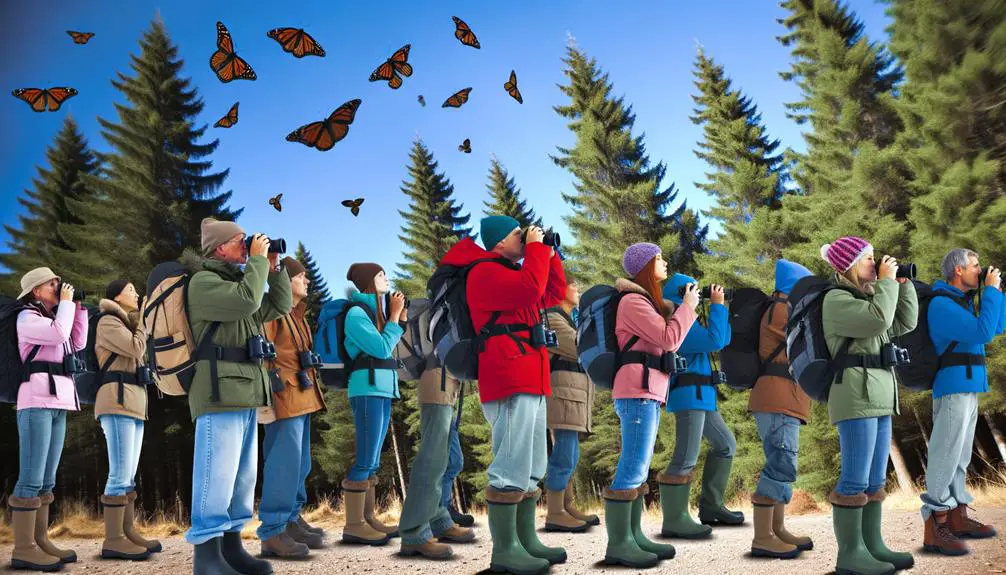
To guarantee an enriching and safe experience at the Monarch Butterflies Sanctuary, it is essential to pack appropriately for both the environmental conditions and the activities planned.
Given the sanctuary's elevation and potential for fluctuating temperatures, layered clothing is highly recommended. Sturdy hiking boots are vital for traversing the often rugged trails.
Binoculars and a camera will enhance your wildlife observation, allowing closer inspection of the monarchs without disturbing their habitat. Additionally, biodegradable sunscreen and insect repellent secure personal comfort while minimizing environmental impact.
Carrying a reusable water bottle and energy-rich snacks will help sustain your energy levels during the hike. Finally, a lightweight backpack to carry these essentials will facilitate a comfortable and hands-free exploration.
Conservation Efforts
Conservation efforts for the Monarch Butterflies Sanctuary necessitate rigorous habitat protection strategies, including the preservation and restoration of milkweed and nectar plant populations critical to the butterflies' lifecycle.
Equally imperative is fostering community involvement initiatives that educate and empower local populations to participate in habitat conservation and monitoring activities.
These dual approaches are pivotal to ensuring the long-term survival and resilience of monarch populations against environmental threats.
Habitat Protection Strategies
Ensuring the survival of monarch butterflies necessitates the implementation of multifaceted habitat protection strategies that address both breeding and migratory needs. This approach integrates scientific research and environmental stewardship to foster sustainable ecosystems.
Key strategies include:
- Reforestation and Habitat Restoration: Replanting native flora to restore degraded habitats.
- Pollinator-Friendly Agricultural Practices: Encouraging the use of organic farming techniques to reduce pesticide use.
- Legislation and Policy Advocacy: Implementing laws that protect critical habitats and regulate harmful activities.
Community Involvement Initiatives
Engaging local communities in conservation efforts is paramount for the long-term success of monarch butterfly sanctuaries, as grassroots involvement fosters a sense of stewardship and collective responsibility.
The Santuario Piedra Herrada has implemented community-based programs focusing on education and sustainable livelihoods. Local residents are trained as eco-tour guides, providing them with economic incentives tied directly to conservation.
Additionally, workshops on sustainable agriculture and reforestation empower communities to restore critical habitats. Monitoring programs involve citizens in scientific data collection, enhancing local engagement and ensuring accurate tracking of butterfly populations.
These initiatives not only protect the monarchs but also promote socio-economic development, creating a harmonious balance between human needs and ecological preservation.
Local Attractions and Activities
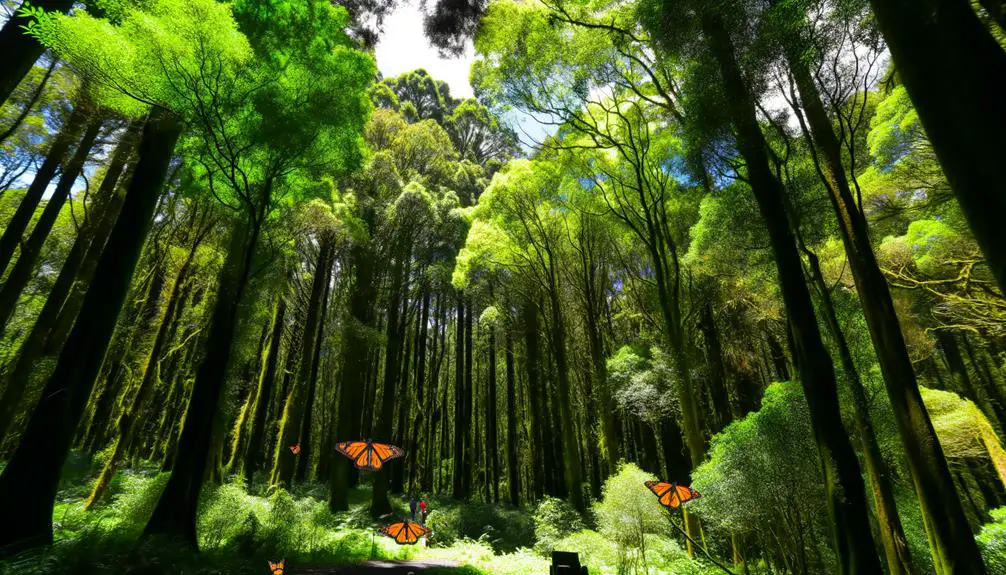
Visitors to the Monarch Butterflies Sanctuary can explore a range of local attractions and activities designed to enhance their understanding of these remarkable insects and their critical habitats. These offerings aim to foster an appreciation for the delicate balance of ecosystems and the need for conservation efforts.
- Guided Nature Walks: Expert-led tours through the sanctuary provide insights into monarch behavior, migration patterns, and the flora that sustains them.
- Educational Workshops: Interactive sessions educate visitors on the lifecycle of monarchs and the environmental challenges they face.
- Butterfly Tagging: Participate in citizen science by tagging butterflies to help track their migration.
Each activity underscores the sanctuary's mission of conservation and education.
Conclusion
The Piedra Herrada Sanctuary serves as an essential refuge for the migrating monarch butterflies, whose journey underscores the delicate balance of ecosystems.
Conservation efforts at the sanctuary highlight the importance of preserving this natural phenomenon.
What will be the fate of these majestic creatures if their habitats continue to vanish?
By visiting and supporting these sanctuaries, one can contribute to protecting the monarch butterfly migration, ensuring that future generations may witness this extraordinary spectacle.



